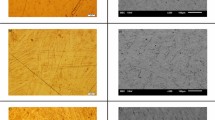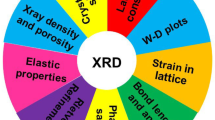Abstract
This study investigates the impact of varied nickel content levels (ranging from 0 to 20 wt%) and annealing temperatures (ranging from 300 to 600 °C) on the magnetic and structural characteristics of nanostructured FeCu alloys. The nanostructured alloys were synthesized using high-energy ball milling, followed by annealing in a controlled atmosphere. The structural evolution and phase formation were analyzed using X-ray diffraction (XRD), revealing the presence of a bimodal nanocrystalline structure. Magnetic properties were characterized using a vibrating sample magnetometer (VSM), showing that an increase in nickel content enhances the saturation magnetization, reaching a maximum at 15-wt% Ni. Additionally, higher annealing temperatures lead to reduced grain size and increased magnetic coercivity. These findings underscore the substantial influence of nickel content and annealing temperature control on the magnetic and structural attributes of nanostructured FeCu alloys. The results not only contribute to a better understanding of the fundamental properties of these alloys but also highlight their potential utility in diverse technological applications, such as magnetic sensors, data storage devices, and magnetic shielding materials.











Similar content being viewed by others
Data availability
The datasets generated and analyzed during the present study are accessible upon reasonable request to the corresponding author.
References
H. Gleiter, Nanostructured materials: basic concepts and microstructure. Acta Mater. 48, 1 (2000)
T. Simsek, B. Avar, S. Ozcan, A.K. Chattopadhyay, B. Kalkan, Solid-state synthesis and characterization of the stable nanostructured Ni21Ti2B6 phase. Bassic Solid State Phys. 258(5), 2000571 (2021). https://doi.org/10.1002/pssb.202000571
B. Kalkan, T. Simsek, B. Avar, Local atomic configurations in mechanically alloyed amorphous (FeCoNi)70Ti10B20 powders. J. Alloys Compd. (2023). https://doi.org/10.1016/j.jallcom.2023.170667
B. Avar, A.K. Chattopadhyay, T. Simsek, T. Simsek, S. Ozcan, B. Kalkan, Synthesis and characterization of amorphous-nanocrystalline Fe70Cr10Nb10B10 powders by mechanical alloying. Appl. Phys. A 128, 537 (2022). https://doi.org/10.1007/s00339-022-05680-0
C. Suryanarayana, A.A. Al-Joubori, Z. Wang, Nanostructured materials and nanocomposites by mechanical alloying: an overview. Met. Mater. Int. 28, 41 (2022)
J.Z. Jiang, C. Gente, R. Bormann, Mechanical alloying in the Fe–Cu system. Mater. Sci. Eng. A 242, 268 (1998)
A.H. Alami, A.A. Hawili, N. Chaker, Experiments on surface hardening of aluminum components by high-energy centrifugal milling. Int. J. Adv. Manuf. Tech. 95, 3855 (2018)
A.H. Alami, J. Abed, M. Almheiri, A. Alketbi, C. Aokal, Fe–Cu metastable material as a mesoporous layer for dye‐sensitized solar cells. Energy Sci. Eng. 4, 166 (2016)
A.H. Alami, J. Abed, M. Almheiri, A. Alketbi, The Fe–Cu metastable nano-scale compound for enhanced absorption in the UV–Vis and NIR ranges. Metall. Mater. Trans. E 2, 229–235 (2015). https://doi.org/10.1007/s40553-015-0060-y
M. Al Awadhi, M. Egilmez, W. Abuzaid, A.H. Alami, Magnetic properties and non-fermi liquid behaviour in mechanically alloyed FeCu. J. Alloys Compd. 890, 161812 (2022)
A. Yakin, T. Simsek, B. Avar, T. Simsek, A.K. Chattopadhyay, A review of soft magnetic properties of mechanically alloyed amorphous and nanocrystalline powders. Emergent Mater. 6, 453–481 (2023). https://doi.org/10.1007/s42247-023-00485-0
A. Yakın, T. Şimşek, B. Avar, A.K. Chattopadhyay, S. Özcan, T. Şimşek, The effect of Cr and Nb addition on the structural, morphological, and magnetic properties of the mechanically alloyed high entropy FeCoNi alloys. Appl. Phys. A 128, 686 (2022). https://doi.org/10.1007/s00339-022-05836-y
E.F. Kneller, Magnetic and structural properties of metastable Fe–Cu solid solutions. J. Appl. Phys. 35, 2210 (1964)
C.L. Fu, A.J. Freeman, Electronic and magnetic properties of the fcc fe (001) thin films: Fe/Cu (001) and Cu/Fe/Cu (001). Phys. Rev. B 35, 925 (1987)
H.R. Lashgari, D. Chu, S. Xie, H. Sun, M. Ferry, S. Li, Composition dependence of the microstructure and soft magnetic properties of Fe-based amorphous/nanocrystalline alloys: a review study. J. Non-cryst. Solids. 391, 61 (2014)
K. Hono, D.H. Ping, M. Ohnuma, H. Onodera, Cu clustering and Si partitioning in the early crystallization stage of an Fe73.5Si13.5B9Nb3Cu1 amorphous alloy. Acta Mater. 47, 997 (1999)
S. Mourdikoudis, R.M. Pallares, N.T. Thanh, Characterization techniques for nanoparticles: comparison and complementarity upon studying nanoparticle properties. Nanoscale. 10, 12934 (2018)
Y.I. Petrov, E.A. Shafranovsky, N.S. Perov, A.P. Kuznetsov, G.V. Karpov, Magnetism of aerosol FeCu nanoparticles in a wide concentration range. Doklady Phys. Chem. 449, 78 (2013)
S. Shu, B.D. Wirth, P.B. Wells, D.D. Morgan, G.R. Odette, Multi-technique characterization of the precipitates in thermally aged and neutron irradiated Fe–Cu and Fe–Cu–Mn model alloys: atom probe tomography reconstruction implications. Acta Mater. 146, 237 (2018)
A. Younes, N. Dilmi, M. Khorchef, A. Bouamer, N.E. Bacha, M. Zergoug, Structural and magnetic properties of FeCuNi nanostructured produced by mechanical alloying. Appl. Surf. Sci. 446, 258 (2018)
M.R. Rahul, G. Phanikumar, Solidification behaviour of undercooled equiatomic FeCuNi alloy. J. Alloys Compd. 815, 152334 (2020)
J. Li, Z. Tian, Q. Xie, S. Xiong, Component effect on microstructure of rapidly cooled FeCuNi alloys. Chem. Phys. Lett. 753, 137630 (2020)
A. Younes, A. Bouamer, R. Amraoui, N. Metidji, M. Guessoum, A. Abada, Magnetic and structural properties of Fe–Ni and Fe–Ni–Gr based nanostructured alloys synthesized by mechanical alloying. J. Nano Res. 78, 1 (2023)
Z. Rao, D. Ponge, F. Koermann, Y. Ikeda, O. Schneeweiss, M. Friák, Z. Li, Invar effects in FeNiCo medium entropy alloys: from an invar treasure map to alloy design. Intermetallics 111, 106520 (2019)
N. Suresh Kumar, R. Padma Suvarna, K. Chandra Babu Naidu, M.S. S.R.K, R. Pothu, R. Boddula, Magnetic Alloy Materials, Properties and Applications. Alloy Mater. Their Allied Appl. (2020). https://doi.org/10.1002/9781119654919.ch5
A. Younes, R. Amraoui, A. Manseri, F. Smaili, The impact of Cu, Ni and Fe2O3 on the magnetic behavior and structural properties of FeSiO2 nanocomposite synthesized through ball milling. Phys. Scr. 98, 115536 (2023)
D.N. Trong, Factors affecting the depth of the Earth’s surface on the heterogeneous dynamics of Cu1–xNix alloy, x = 0.1, 0.3, 0.5, 0.7, 0.9 by molecular dynamics simulation method. Mater. Today Commun. 29, 102812 (2021)
M.I. Lerner, A.V. Pervikov, E.A. Glazkova, N.V. Svarovskaya, A.S. Lozhkomoev, S.G. Psakhie, Structures of binary metallic nanoparticles produced by electrical explosion of two wires from immiscible elements. Powder Technol. 288, 371 (2016)
A.H. Alami, A.A. Hawili, Synthesis, characterization and applications of FeCu alloys. Appl. Surf. Sci. Adv. 1, 100027 (2020)
Y.P. Xie, S.J. Zhao, First principles study of Al and Ni segregation to the α-Fe/Cu (100) coherent interface and their effects on the interfacial cohesion. Comput. Mater. Sci. 63, 329 (2012)
L.S. Zhu, S.J. Zhao, Influence of Ni on Cu precipitation in Fe–Cu–Ni ternary alloy by an atomic study. Chin. Phys. B 23, 063601 (2014)
O.I. Gorbatov, Y.N.P.A. Gornostyrev, Korzhavyi, A.V. Ruban, Effect of Ni and Mn on the formation of Cu precipitates in α-Fe. Scripta Mater. 102, 11 (2015)
L. Fu, J. Yang, Q. Bi, W. Liu, Combustion synthesis immiscible nanostructured Fe–Cu alloy. J. Alloys Compd. 482, L22 (2009)
R.A. Ricks, P.R. Howell, R.W.K. Honeycombe, The effect of Ni on the decomposition of austenite in Fe–Cu alloys. Metall. Trans. A 10A, 1049 (1979)
Y. Wang, J. Yin, X. Liu, R. Wang, H. Hou, J. Wang, Precipitation kinetics in binary Fe–Cu and Ternary Fe–Cu–Ni alloys via kMC method. Progress Nat. Science: Mater. Int. 27(4), 460–466 (2017). https://doi.org/10.1016/j.pnsc.2017.06.005
A. Younes, N. Kherrouba, Eddy current and magnetic evaluation of nanostructured iron–cobalt produced by ball-milling. Emerg. Mater. Res. 11, 268 (2022)
P. Scherrer, Estimation of the size and internal structure of colloidal particles by means of röntgen. Nachr. Ges Wiss Göttingen. 2, 98–100 (1918)
C. Crozet, M. Verdier, S. Lay, Effect of cooling rates on γ→ α transformation and metastable states in Fe–Cu alloys with addition of Ni. Met. Mater. Int. 24, 681 (2018)
P. Asghari-Rad, Y. Kim, N.T.C. Nguyen, H.S. Kim, Fabrication of FeCuNi alloy by mechanical alloying followed by consolidation using high-pressure torsion. J. Powder Mater. 27, 1 (2020)
Y.A. Yoshizawa, S. Oguma, K. Yamauchi, New Fe-based soft magnetic alloys composed of ultrafine grain structure. J. Appl. Phys. 64, 6044 (1988)
B.D. Cullity, C. D. Graham Introduction to magnetic materials, Second edition, IEEE Press, 445 Hoes Lane, Piscataway, NJ 08854, John Wiley & Sons, (2011). ISBN 978-0-471-47741-9
P. Gorria, D. Martínez-Blanco, J.A. Blanco, A. Hernando, J.S. Garitaonandia, R.I. Barquín, Smith, Invar effect in fcc-FeCu solid solutions. Phys. Rev. B 69, 214421 (2004)
D. Martínez-Blanco, P. Gorria, J.A. Blanco, R.I. Smith, Temperature induced phase transformations and microstructural changes in nanostructured FeCu solid solutions using in situ neutron powder thermo-diffraction. J. Alloys Compd. 483, 549 (2009)
S. Khmelevskyi, P. Mohn, First-principles investigation of ferromagnetism and Invar effect in Fcc Fe–Cu alloys. Phys. Rev. B 71, 144423 (2005)
M.F. De Campos, S.A. Loureiro, D. Rodrigues, M.D.C. Silva, N.B. Lima, Estimative of the stacking fault energy for a FeNi (50/50) alloy and a 316L stainless steel. Mater. Sci. Forum. 591, 3 (2008)
D.A. Milkova, A.I. Bazlov, E.N. Zanaeva, A.Y. Churyumov, I.V. Strochko, E.V. Ubyivovk, A. Inoue, (Fe-Ni)-based glassy alloy containing nb and cu with excellent soft magnetic properties. J. Non-cryst. Solids 609, 122234 (2023)
D. Palanisamy, A. Kovács, O. Hegde, R.E. Dunin-Borkowski, D. Raabe, T. Hickel, B. Gault, Influence of crystalline defects on magnetic nanodomains in a rare-earth-free magnetocrystalline anisotropic alloy. Phys. Rev. Mater. 5, 064403 (2021)
X. Li, Z. Tian, Q. Xie, K. Dong, The topologically close-packed Fe70Cu15Ni15 nanoparticles-a simulation study. Vacuum 193, 110523 (2021)
E.S.R. Gopal, Specific heats at low temperatures (Springer, New York, 2012), pp.1–240. https://doi.org/10.1007/978-1-4684-9081-7
M. Amir, H. Gungunes, Y. Slimani, N. Tashkandi, H. El Sayed, F. Aldakheel, M. Sertkol, H. Sozeri, A. Manikandan, I. Ercan, Mössbauer studies and magnetic properties of cubic CuFe2O4 nanoparticles. J. Supercond. Nov. Magn. 32, 557 (2019)
A. Faraz, A. Maqsood, N.M. Ahmad, F. Ur-Rehman, S. Ameer, Mg0.50Cu0.5-xNixFe2O4 spinel nanoferrites: Structural, Electrical, magnetic and YK angle studies. J. Nano Res. 17, 99 (2012)
K. Tanbir, M.P. Ghosh, R.K. Singh, M. Kar, S. Mukherjee, Effect of doping different rare earth ions on microstructural, optical, and magnetic properties of nickel–cobalt ferrite nanoparticles. J. Mater. Sci. Mater. Elec. 31, 435 (2020)
T. Şimşek, T. Şimşek, B. Avar, Ş Özcan, Investigation of structural and magnetic properties of the FeCoNi nanocrystalline powder alloys. Eur. J. Sci. Technol. 32, 616–621 (2021). https://doi.org/10.31590/ejosat.1048336
Funding
The author has not disclosed any funding.
Author information
Authors and Affiliations
Corresponding author
Ethics declarations
Competing interest
The authors affirm that they do not possess any recognized conflicting financial interests or personal relationships that might have seemed to influence the findings presented in this paper.
Ethical approval
This article adheres to the ethical standards set forth by the journal.
Additional information
Publisher’s Note
Springer Nature remains neutral with regard to jurisdictional claims in published maps and institutional affiliations.
Rights and permissions
Springer Nature or its licensor (e.g. a society or other partner) holds exclusive rights to this article under a publishing agreement with the author(s) or other rightsholder(s); author self-archiving of the accepted manuscript version of this article is solely governed by the terms of such publishing agreement and applicable law.
About this article
Cite this article
Younes, A. Effects of nickel content and annealing temperature on the magnetic characteristics of nanostructured FeCu alloys. J Mater Sci: Mater Electron 35, 535 (2024). https://doi.org/10.1007/s10854-024-12291-3
Received:
Accepted:
Published:
DOI: https://doi.org/10.1007/s10854-024-12291-3




